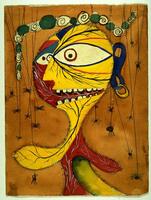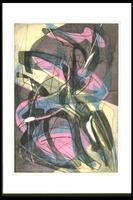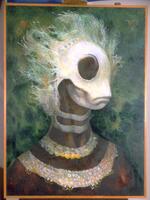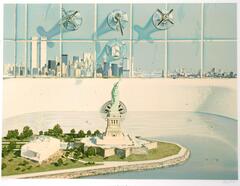59 Items in this Learning Collection
Copyright
Now the Dove and the Leopard Wrestle
2012/1.225
Title
Now the Dove and the Leopard Wrestle
Artist(s)
Romare Bearden
Artist Nationality
American (North American)
Object Creation Date
1946
Medium & Support
oil on canvas
Dimensions
23 1/2 in x 29 1/4 in (59.69 cm x 74.3 cm);32 in x 38 in x 2 1/2 in (81.28 cm x 96.52 cm x 6.35 cm)
Credit Line
Transfer from the William L. Clements Library, University of Michigan, gift of Clarence Wolf, February 1997
Label copy
In Focus 2013
Romare Bearden
“The artist has to be something like the whale, swimming with his mouth wide open, absorbing everything until he has what he needs.”
Romare Bearden was a man of great intellectual curiosity and manifold interests. During the Harlem Renaissance of his childhood, Bearden was surrounded by people who fed his intellect and imagination. His friends were other artists, writers, poets, and jazz musicians, including Langston Hughes, Countee Cullen, Ralph Ellison, Duke Ellington, Paul Robeson, W.E.B. Du Bois, Mary McLeod Bethune, George Grosz, and Stuart Davis, among others. He took his imagery from their words and ideas as well as everyday life. The painting on display here demonstrates the importance of two other influences: the Cubism of Pablo Picasso and the poetry of Federico García Lorca.
This painting was completed at a time when Bearden was inspired by powerful literary sources, including Rabelais, Homer, and Lorca, writers who share themes of violence, suffering, death, and resurrection. A critic of the time described the continuity between the themes of these writers as the struggle against darkness. Now the Dove and the Leopard Wrestle takes its title from a line in Lorca’s poem Lament for Ignacio Sanchez Mejias. Bearden met Lorca when he was in the United States from June 1929 to March 1930. He also may have met the bullfighter Ignacio Sanchez Mejias when he visited Lorca in late 1929. These (possible) meetings could be a reason for the artist’s selection of this poem. The scene portrayed, however, does not represent a dove or leopard, nor does it portray the death of Mejias in 1934. Rather, the violent attack of the bull on the horse is more of an homage to the “religious mystery” of the bullfight (Lorca’s term) that held such a potent attraction for Lorca, Mejias, Picasso, and Bearden. Although the literary link is to Lorca, the stylistic reference—the overlapping, intersecting, flat, and rounded forms contained in Cubist space—is evidence of Bearden’s special interest in Picasso.
This important early work by Bearden was given to the University of Michigan’s Clements Library by Clarence Wolf, a frequent benefactor to the Clements. Wolf’s father, Ben, was a painter and art critic who reviewed Bearden’s early exhibitions and acquired this painting directly from Bearden. Ben Wolf felt that Bearden was “one of the most exciting creative artists” to emerge in a long time. The painting was transferred to UMMA this year where it will be an important resource for students, visitors, and scholars.
Pam Reister
Curator for Museum Teaching and Learning
[label]
Romare Bearden
United States, 1911–1988
Now the Dove and the Leopard Wrestle
1946
Oil on canvas
Transfer from the William L. Clements Library, University of Michigan,
gift of Clarence Wolf, February 1997, 2012/1.225
; Label copy
Romare Bearden
United States, 1911–1988
Now the Dove and the Leopard Wrestle
1946
Oil on canvas
Transfer from the William L. Clements Library, University of Michigan,
gift of Clarence Wolf, February 1997, 2012/1.225
This painting was completed not long after the end of World War II, at a time when Bearden was inspired by powerful literary sources that explored themes of violence, suffering, death, and resurrection—what a critic of the time described as “the struggle against darkness.” It is one of a number of works he based on Lament for Ignacio Sanchez Mejias, a poem by the Spanish writer Federico García Lorca (1898–1936) about a famous bullfighter who died in 1934. The painting takes its title from a line that evokes the toreador’s life-or-death battle with the bull, but Bearden does not portray a dove or leopard, nor Mejias’s death. Rather, the violent attack on the horse conveys both the drama and intensity of the moment and what Lorca called the “religious mystery” of the bullfight. The overlapping and intersection of flat, rounded forms in a shallow space are evidence of Bearden’s interest in the work of Pablo Picasso (1881–1973), whose work is also on display in this gallery.
Subject matter
As part of the Harlem Artists Guild, Bearden came in contact with a number of prominent European modernists in New York and this work shows his interest in the work of the Cubists, like Pablo Picasso. This painting was completed at a time when Bearden was inspired by powerful literary sources, including Rabelais, Homer, and Lorca, writers who share themes of violence, suffering, death, and resurrection. A critic of the time described the continuity between the themes of these writers as the struggle against darkness. The title comes from a line in the poem, Lament for the Death of Ignacio Sánchez Mejías by Frederico Garcia Lorca. Bearden had already met Lorca when the poet was in the United States from June 1929 to March 1930. The scene portrayed, however, does not represent a dove or leopard. Rather, the horse likely stands in for Mejias, who died as a result of being gored in a bullfight in 1934. The horse appears in agony, with his body is twisted and its mouth is open, screaming. By combining bright colors and overlapping lines, Bearden creates a dramatic sense of dynamism and movement in this work.
Physical Description
At the center of the painting, two animals meet: a horse and a bull. Painted in a variety of colors, the two animals are abstracted in a Cubist style. The painting is signed (u.r.) in black paint "Bearden".
Primary Object Classification
Painting
Collection Area
Modern and Contemporary
Rights
If you are interested in using an image for a publication, please visit http://umma.umich.edu/request-image for more information and to fill out the online Image Rights and Reproductions Request Form.
Keywords
Abstract (fine arts style)
African American
Cubist
bullfights
bulls (animals)
pain (sensation)
riding horses (animals)
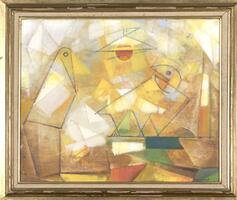
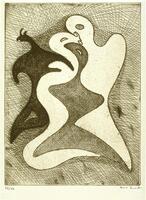
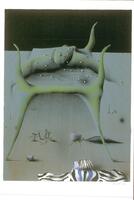
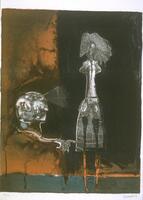

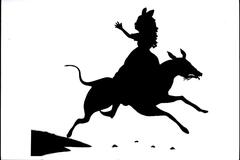

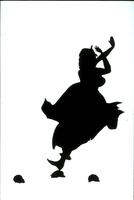

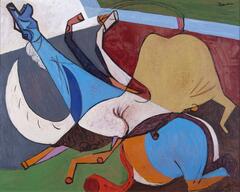
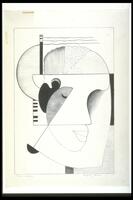
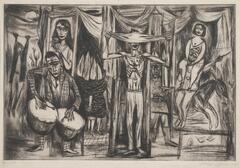

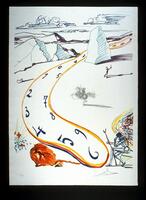
![In this mixed-media print, there is a white background with black outlines of facial features, lips and an eye, and a creature in the bottom left. In the upper left corner there is a rectanglular sheet in cream layered on top; a wavy vertical design stretches diagonally from the top of the rectangle to the bottom in yellow, red, and blue. Within this sheet, there are small figures at the center left drawn in black. To the right in the sheet, there is a collaged image of one of the artist's paintings, incorporated into a cube. Above, there are drawn birds. There is a small mechanical-like figure on the sheet at the bottom left. At the center of the print, in the cream page, the artist signed "Dali" and dated the print "1975. To the bottom left, on the larger white page, there is text inscribed in the plate, mirrored and someone illegible, that possibly reads "Leill Ciclopeer Alucire la bouche Almient tire / Lula [illegible]." The print is number at the lower left in pencil. In this mixed-media print, there is a white background with black outlines of facial features, lips and an eye, and a creature in the bottom left. In the upper left corner there is a rectanglular sheet in cream layered on top; a wavy vertical design stretches diagonally from the top of the rectangle to the bottom in yellow, red, and blue. Within this sheet, there are small figures at the center left drawn in black. To the right in the sheet, there is a collaged image of one of the artist's paintings, incorporated into a cube. Above, there are drawn birds. There is a small mechanical-like figure on the sheet at the bottom left. At the center of the print, in the cream page, the artist signed "Dali" and dated the print "1975. To the bottom left, on the larger white page, there is text inscribed in the plate, mirrored and someone illegible, that possibly reads "Leill Ciclopeer Alucire la bouche Almient tire / Lula [illegible]." The print is number at the lower left in pencil.](/media/W1siZiIsIjIwMjIvMDUvMjUvMWUwenVmM3Nlel9kZWZhdWx0LmpwZyJdLFsicCIsInRodW1iIiwiMjQweDIwMCJdXQ?sha=03c3865ec6fdec9d)
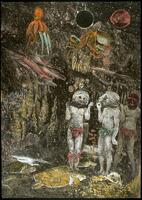
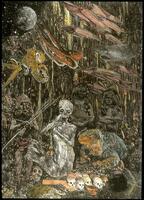
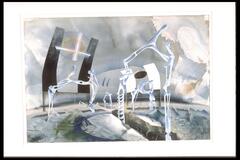
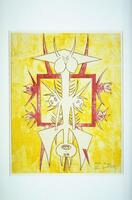

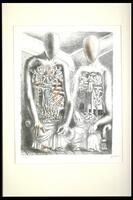

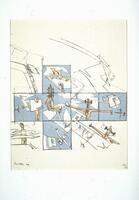
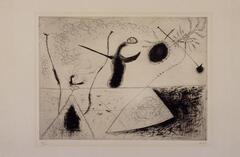
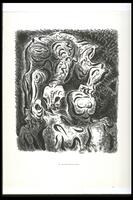
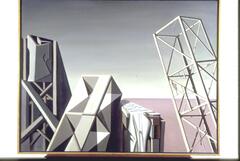

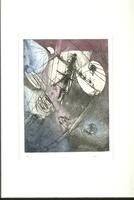


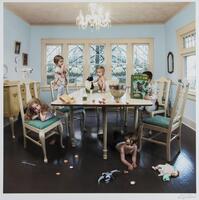
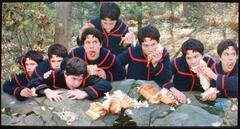
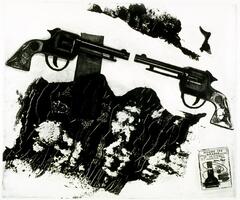
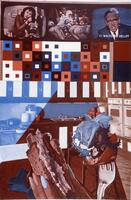
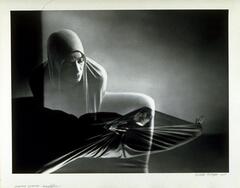
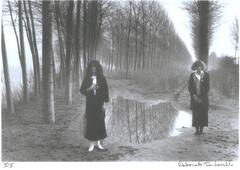

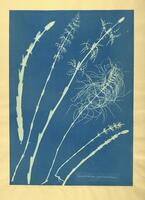
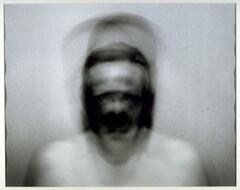
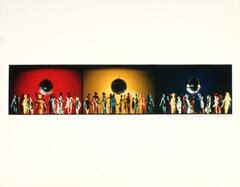


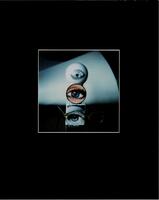

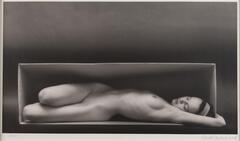
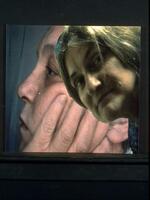
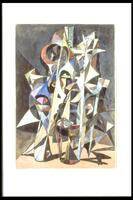
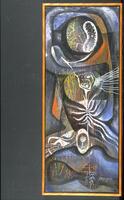
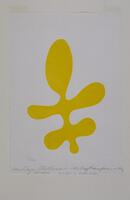

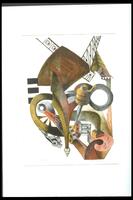
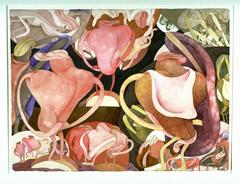
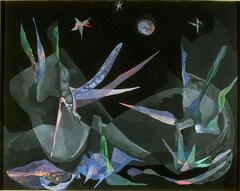

![A clear glass bubble rests on the bowl of a plain white clay pipe. Along the stem of the pipe are the words, "Ce que [sic] manque à nous tous." A clear glass bubble rests on the bowl of a plain white clay pipe. Along the stem of the pipe are the words, "Ce que [sic] manque à nous tous."](/media/W1siZiIsIjIwMjIvMDkvMjQvMmR5MHViN2o5Yl9kZWZhdWx0LmpwZyJdLFsicCIsInRodW1iIiwiMjQweDIwMCJdXQ?sha=e23a50659ff4d560)
